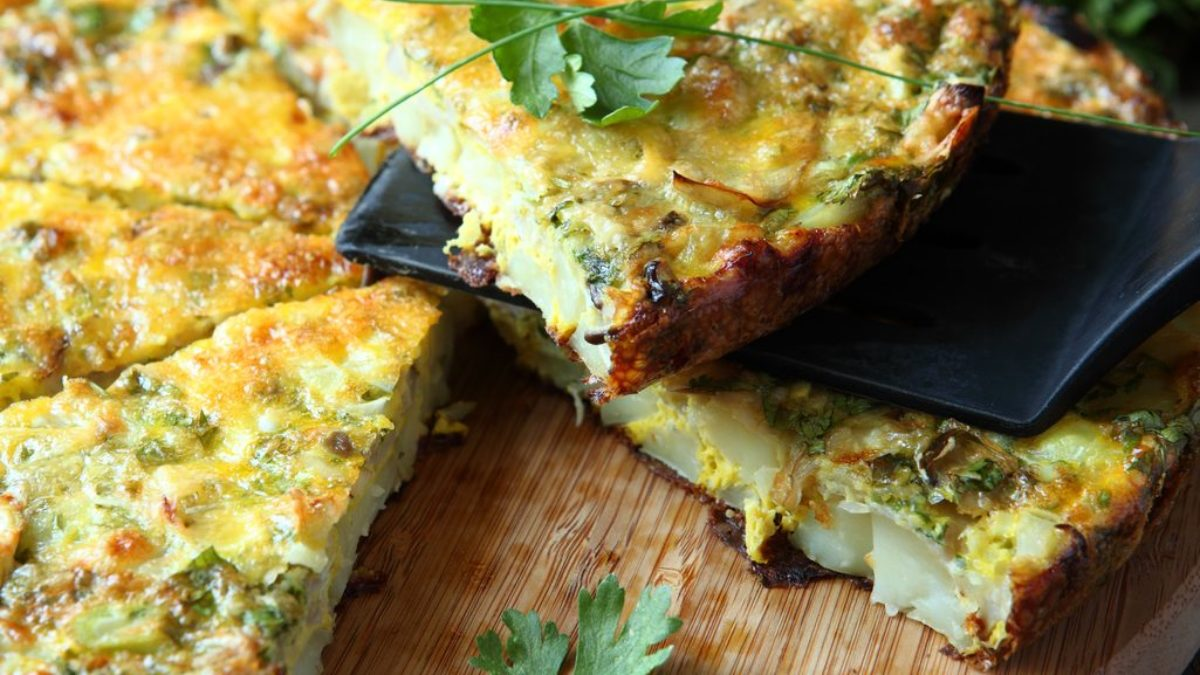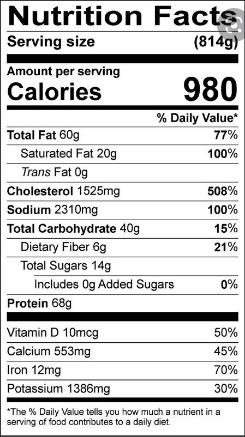A frittata is a simple and quick-to-make flat, firm Italian omelet. While it’s perfect for a weekend breakfast, it’s also delicious for dinner. Unlike the more delicate French omelet, it’s also a terrific way to utilize any leftover vegetables or meat.
Frittata Nutrition Facts
What Is Frittata?
The frittata is an Italian meal similar to an omelet in composition. The egg mixture is not folded and finished on the stovetop like an omelet. Most frittata variations begin with a few minutes on the stovetop until the bottom layer of the egg mixture has hardened, then bake for half an hour to an hour, depending on the size and recipe. The traditional Italian frittata could have been a significant supper during Lent. It would not have been served with meats in these circumstances, but rather with grated cheese and a few vegetables. According to food historians, the frittata predates the omelet in origin. Frittata recipes can be simple, and the result is great for brunches or lunches because it’s usually served at room temperature rather than hot like an omelet. Additionally, some recipe versions are not initially fried, allowing one to bake a considerable frittata in a glass baking dish that may serve many people.
Tips For Cooking Frittata
Here are some best tips for cooking frittata:
Pan Size Matters
Your finished product’s cooking time and appearance are affected by the pan’s size, shape, and material you use. Use a cast-iron skillet for a more classic look, and make sure it’s well-seasoned to prevent the eggs from sticking. Also, because cast iron holds a lot of heat, you should take the frittata out of the oven a little earlier to allow it to finish cooking. However, a large, oven-safe non-stick skillet will suffice. Epicurious recommends using any two-quart baking dish for an eight-egg frittata. Just keep in mind that if you use a larger pan than the recipe calls for, you’ll need to plan for a shorter baking time to compensate for the ensuing thinness.
Find Balance Between Egg and Dairy
To add richness to frittatas, many recipes ask for adding dairy. For eight large eggs, a conventional rule of thumb is to use half a cup of milk. However, there is some leeway in terms of dairy selection and amounts. For 12 giant eggs, “Martha Stewart’s Cooking School” suggested adding a quarter cup of heavy cream. Don’t be afraid to try various ingredients, such as sour cream or creme fraiche.
Cook the Add-ins First
Cook the fillings you want to put in the eggs ahead of time. This isn’t an issue if you utilize leftovers from dinners, such as beef, sausage, or baked potatoes. Fresh ingredients like tomatoes, mushrooms, and onions, on the other hand, should be cut into small pieces, cooked, and drained before being combined into the beaten eggs. According to Bon Appetit, fresh produce includes moisture, which could make your omelet soggy. Use your imagination when it comes to the add-ins, tailoring the frittata to your preferences and what you have on hand. Baked potato, onion, kale, roasted red peppers, and chopped olives were suggested by the Pioneer Woman. On the other hand, Epicurious suggested dishes using salmon, asparagus, chives, and parsley.
Pick the Right Cheese
Whatever toppings you add to your frittata, choosing a complementing cheese that will give it the proper texture is critical, and combining Monterey Jack and Romano cheeses for added taste or using feta to provide a Greek touch. Cheddar or gruyere will melt and pour through the eggs beautifully. A sprinkling of aged Parmesan on top of the cooked eggs, on the other hand, would be preferable.
Seasoning Means Flavor
Season the eggs well before frying to bring out their natural flavors. According to Alton Brown, mix in a pinch of salt and half a teaspoon of black pepper. Season your add-ins as well, but keep the amounts in mind if you’re using salty food like bacon.
Avoid Overbaking
Place the frittata in an oven preheated to 350 degrees Fahrenheit after allowing the eggs to set. An omelet with eight eggs will take 16 to 18 minutes to prepare, while a 12-egg omelet will take 20 to 30 minutes. Keep a tight watch on the pan in any case, and aim for a soft, custard-like texture. Bon Appetit recommended adding cheese to the top toward the end of the baking process if you want a golden-brown top. This is preferable to risking an unpleasant texture by overcooking the frittata. Brown suggested a quicker and more effective way to achieve that pleasing exterior. The oven must be set to broil for his method to work. Cook the egg dish for 4 to 5 minutes on the stovetop. Then place it in the broiler for 3 to 4 minutes more. Pull it out when it’s lightly browned but still fluffy, chop it up, and serve.
How Healthy Is Frittata?
Here are some health benefits of frittata:
- One frittata serving has 16 grams of unsaturated fats, including heart-healthy omega-3 fatty acids from olive oil. Unsaturated fats can help decrease cholesterol when used in place of saturated fats.
- This frittata might have up to 72g of protein, with whole eggs containing roughly 6g of protein apiece and a cup of cottage cheese containing between 16-24g (approximately).
- Considering how dense specific protein sources are, it’s an outstanding deal.
- Frittatas are nutritious; we don’t need to go on and on about the benefits of eggs, but we know that having all 20 amino acids present in this lovely amount aids in developing muscles and, ultimately, our metabolism.
- The combination of eggs and potatoes provides at least 5% of the daily recommended consumption of all vital elements, although potassium, phosphorus, and zinc are notably abundant in this frittata.
- Potassium is necessary for the proper functioning of your nerves and muscles, as well as the regulation of your heartbeat.
- Zinc strengthens your immune system and maintains appropriate growth and development. You’ll get 28 percent of your daily phosphorus, a mineral that activates enzymes and hormones, aid cell communication, and helps create bone when combined with calcium.
Conclusion
Not only that, but a veggie frittata is satisfying, nutritious, and a versatile breakfast, brunch, lunch, or dinner option. A vegetarian frittata’s nutrition includes protein from the eggs, fiber, healthful carbohydrates, and potent plant-based elements from the vegetables.


